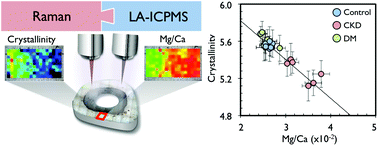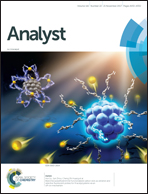The effect of Mg and Sr on the crystallinity of bones evaluated through Raman spectroscopy and laser ablation-ICPMS analysis†
Abstract
We investigated the possible linkage between the crystallinity and elemental ratios (Mg/Ca and Sr/Ca) of the femoral cortical bones of rats with chronic kidney disease (CKD) or diabetes mellitus (DM). The Mg/Ca and Sr/Ca ratios were measured by using the laser ablation-inductively coupled plasma mass spectrometry (LA-ICPMS) technique and the crystallinity was evaluated by Raman spectroscopy on the same sample slice. The measured crystallinity varied significantly along the radial direction, reflecting the heterogeneities in the Mg/Ca ratio for the bone samples. For the endosteal cortical bone of CKD rats, the Mg/Ca ratio became higher. This is explained by the increase of the abundance of Mg in the bone, possibly due to the higher absorption efficiency of Mg in the intestine or due to the lower excretion efficiency of Mg from the kidney. For areas with a higher Mg/Ca ratio, the crystallinity of the bone was significantly more degraded than that for areas with a lower Mg/Ca ratio, suggesting that the substitution of Ca by Mg induced the deterioration of the crystallinity of hydroxyapatite (HAp). In addition, the measured Mg/Ca and Sr/Ca ratios of the bone were positively correlated with those found in serum samples. The data obtained here demonstrated that the metabolic alterations for inorganic elements caused the ionic substitutions of Ca by foreign cationic ions, and that the contents of foreign ions in the bone greatly affected the crystallinity of HAp.



 Please wait while we load your content...
Please wait while we load your content...